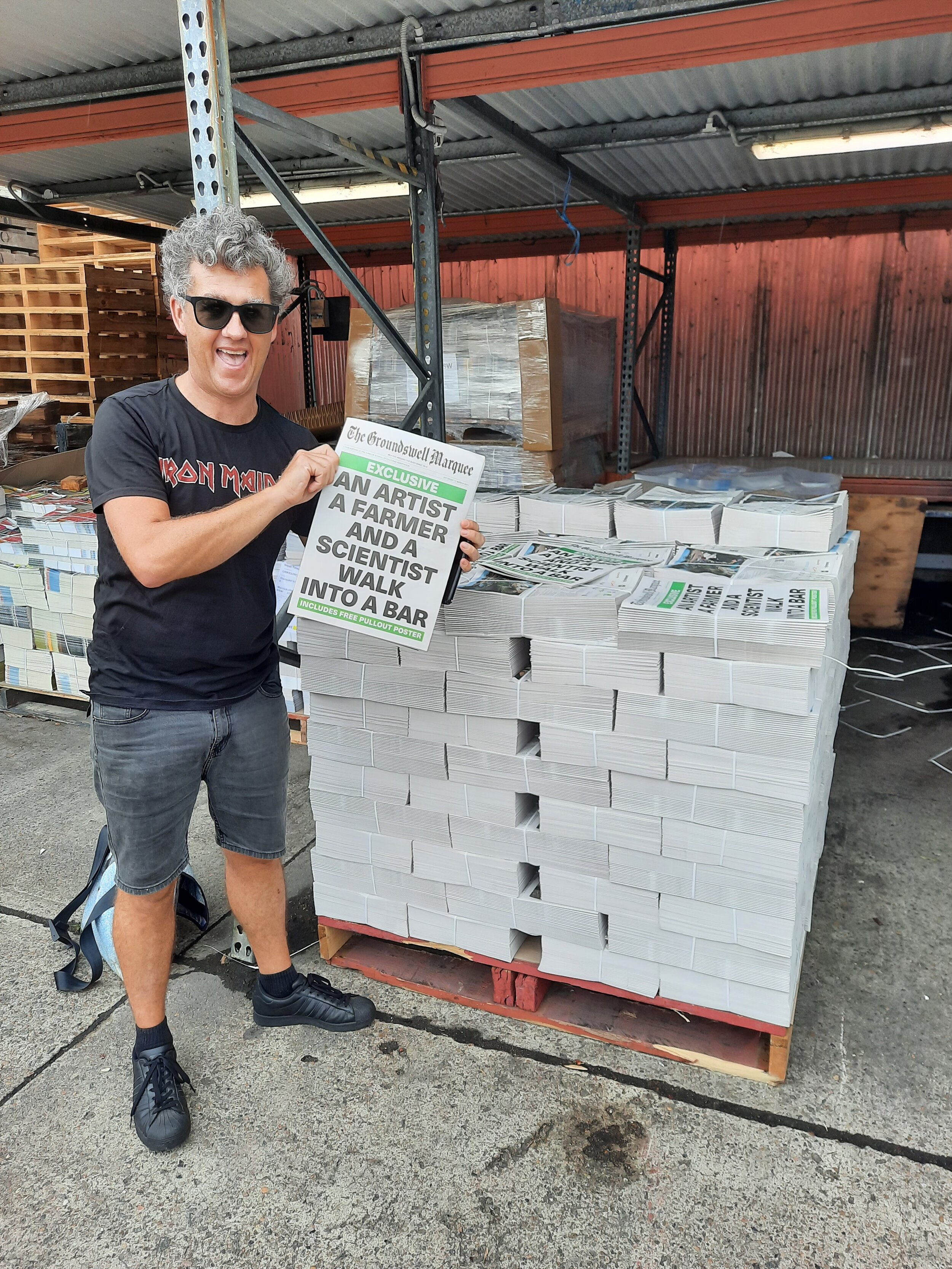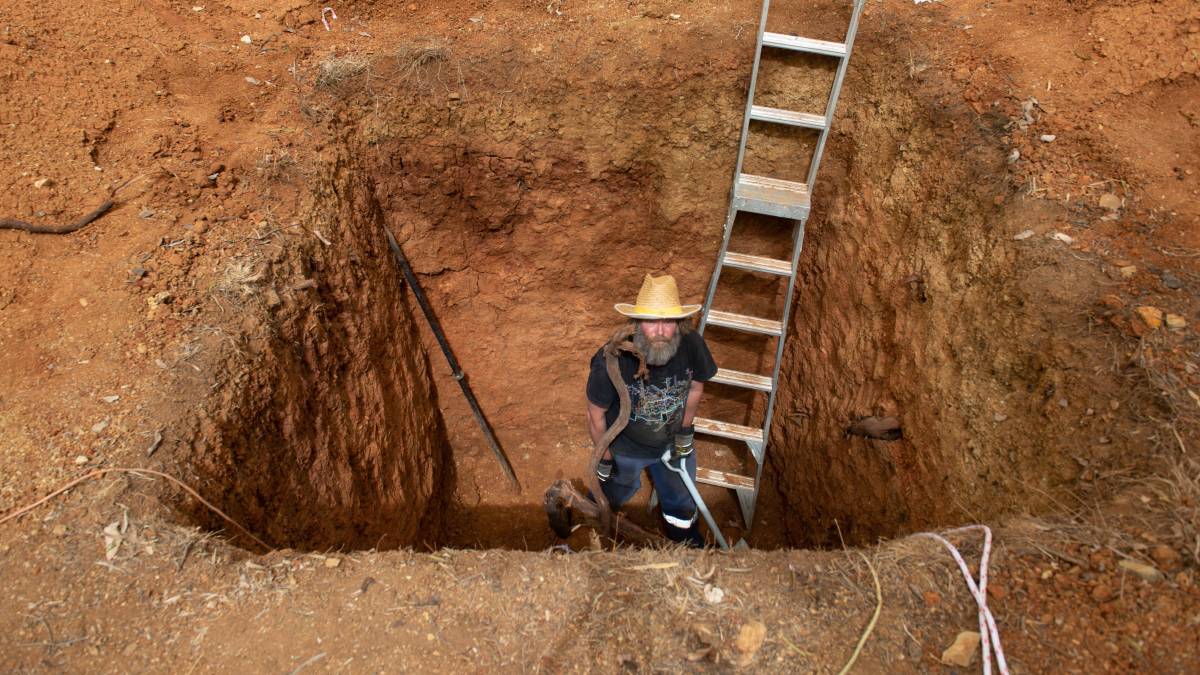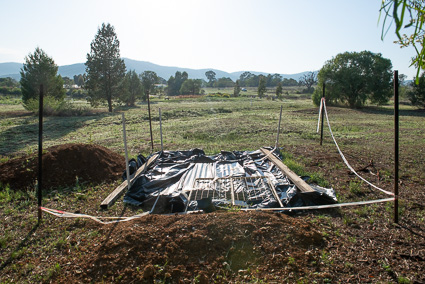It’s 56 pages long, raw and wriggling, and it has a free pull-out poster. We have finally published the newspaper that tells the story of ‘An artist, a farmer and a scientist walk into a bar’, and we’d love to share it with you.
The Earth You Cannot Know
Alex Wisser takes you on a journey into the earth. In his own words, it was a journey that progressed at a rate of several centimetres per day, as he made his way into the ground, hand digging a three metre deep hole that took him through an involved contemplation of the meaning of the earth and the many facets of our relationship to it.
Videography by Justin Hewitson.
This project was supported by 'An artist, a farmer & a scientist walk into a bar…' a major arts initiative in rural Australia in 2018-2020. Involving 9 artists, it was a series of collaborations exploring regenerative farming, soil health, Aboriginal country, solar energy, carbon sequestration and wild foods. It was led by Kandos School of Cultural Adaptation (KSCA), working in partnership with Cementa Inc., The Living Classroom and Starfish Initiatives, and was funded by the NSW Government through Create NSW. You can find out more at https://www.ksca.land/alex-wisser-project
"If the Earth could speak, what would it say?" - Alex's 48 hours in the hole
‘The Hole for The Living Classroom’ has gifted us many puns, and here’s another - it turns out Alex’s existential ambitions go deep, very, very deep. At Groundswell he will conclude his 'hole' project with a performance called ‘Earth Oracle’. He will spend 48 hours within the hole, drinking only water and sleeping under the open sky. The public are invited to pose questions to the earth and on the morning of Saturday 7th September he will respond to these questions from within the hole. He’ll emerge later that day, and will be in conversation with MC Adam Blakester about the project on the main stage. You can read an article about it that was recently published in the Inverell Times.
What would you ask the Earth Oracle?
See below for some hole digging action to get you thinking, courtesy of Justin Hewitson.
the hole is whole
Into the hole
There is no time in a hole, I have no idea what day it is
Do you like my fancy title? I put it up there to express something of the complete schedule scramble my entire project has become. I think it might be day eight when I write this and its 3:00am. I have been so exhausted from digging that I haven’t been able to even approach catching up with my social media obligations. I suspect most of this blog is going to go up after I get home. Just to confuse things further, I will spend this post on a prequel to the hole, a little train of thought that occurred to me while I was still at home, waiting for the residency to begin but never got around to because… I was busy. I can’t remember.
Here I am at whatever day it was when this photo was taken.
As I mentioned in the last post, my original attempt to dig the hole ended in sickness, failure and general catastrophe. I was forced to return home in defeat, to lick my wounds and consider my worth as a human being and an artist. If this sounds melodramatic, it is. Its 3am and I feel I can say whatever I like on the internet and no one will judge me for it.
I spent the intervening months writing grant applications, and making little scraps of money to keep myself and family alive. I don’t want to complain about my life because I like it for the most part, but the postponed work was something that consistently occurred to me. Perhaps this is what became of that youthful experience of the nagging existential need to create stuff because my identity was constructed around the fact that I identified as a person who creates stuff. I don’t know, but it did take me down a particular garden path.
Our little Kandos house on the hill
One of the projects occupying me at the time was the house that Georgie and I now own in Kandos. Its a lovely little house that we were able to get up to livable scratch with a bit of paint and floorboard sanding, but the land it sat on was a sad affair, covered in long suffering kikuyu grass and having only one tree on it. We have, over the last two years planted many trees and are slowly working our way around to converting most of it into a food forest of sorts. The property is on a hill and so most of it is sloping, meaning that there are few places to comfortably drink fluids, eat foods and talk talk. I conceived of putting in what I liked to call a sunken courtyard, cut into the hillside behind our house with a large desiduous tree overhanging to shade it in summer, creating a ‘micro-climate’ in which life forms heretofore unknown in Kandos could thrive and amongst which we would gather to drink refreshing beverages and renew our friendships in perpetuity.
To this end, I contacted a fella with a bobcat and got a quote on what it would cost me to get the job done in a day or two. It wasn’t much. It was more than I could afford at the moment but it was definitely doable if I got some jobs and did some work and collected some money up. I can see myself sitting under that large tree, in the shelter of its shade, enjoying my microclimate and my friends and the veritable rain forest of green and living things that would come to occupy my utopia. The idea that I could get the majority of the work done in two days was impressive. I’d have to get a table and some chairs and yes, the whole growing a tree thing would take two to three decades but its a dream, I was going to have made into a reality in two short days.
As I thought about myself in my socially conducive micro-climate, my delight was insidiously overcome by a depressing thought. One achieved, I would perhaps enjoy my sunken courtyard occasionally, but really, the thrill of its achievement would last for only a short time before it would sink into the reality that is the background to all my dreams and, being the creature that I am, I would quickly acquire another dream that I would then pursue with all of the ardor that I had invested in this now forgotten conquest.
I’m digging the hill
This thought, combined with my unfulfilled need to dig a hole and I thought naw… I’ll dig it out myself. And so I have slowly, over the last several months been removing bits and pieces of the small hill we live on and relocating them to another part of the hill up higher, creating another flat area where we might one day build Georgie a castle or put in a basketball court for Emma. Who knows! As I have been digging out that hill, I reflect on how we live most of our lives within a project, with a goal somewhere over the hill at which we aim and then work towards. Even getting through a day of work can be like this. My thought is that if this space of project-ion is where our being takes place, then perhaps we should spend more time within it, and less time hurrying to get to the end of the process, only to find that we need to invent another project in order to get us along the next lap into the future.
Margaret Robert’s Exhibition “Live in Your Art” predicting our future for us.
This adventure recalled for me the first exhibition we ever hosted at INDEX. Art Space, the ARI space that Georgie and I both lived in and tended for the three years prior to our move to Kandos. The show was called “Live in Your Art” by Margaret Roberts and it reflected on the fact that we were living in an art space, thus superimposing two fundamentally different kinds of space on top of one another, and in doing so, fusing them. This exhibition came to my mind as I dug out the side of the hill behind my house and worried about not making art. As I did so, Georgie labored away building the garden in the front yard through a method of her own devising, which I had come to jokingly call Garden Povera for her use of recycled concrete to create terraces and pathways and her use of bedheads and other tip scavenged oddities as trellases and garden ornaments. All around me, the weeds in the back yard had grown to luxurious heights, a method of building soil recommended to us through our work with KSCA. What was I worried about, I was living in my art, as Margaret Roberts has so presciently pointed out those many years before.
Gardening Povera. I can’t wait till Gardening Australia hears about this one!
Starting on Day three - Back in the hole
For those who haven’t been following the project “An Artist A Farmer and a Scientist walk into a bar…”, I am participating by repeating a work I did in 2014 at Hill End, “A Hole for Hill End”, in which I dug a hole for a number of ironic and non ironic reasons in the historic gold mining town Hill End. You can read about it here, because I blogged about it, which means that I won’t have to blog about it here.
This is the site that greeted me on my return
Anyway, that’s the past and this is the present, and in the present I am repeating what I did in the past, with modifications. That’s the way things go. The idea to repurpose the work for the current project came from the director of our partner organisation The Living Classroom, Rick Hutton, who suggested KSCA might produce a permanent public artwork for The Living Classroom as a part of AFS. I’m not a fan of public artwork (which you can read about here) and was uneasy at the prospect. I eventually came around to the idea of digging the hole. The original hole was ephemeral, and I filled it in after completing it but this time I proposed to make it permanent. My immediate rationale was that it would be an art work that wouldn’t result in a work of art, but instead would produce a classroom. It occurred to me that this was just what The Living Classroom needed. As a facility dedicated to disseminating understanding of regenerative agriculture, horticulture, permaculture, ie the land, their work was exclusively carried out above ground, across which you could walk and talk about what was happening underneath you. What they needed, I reasoned, was a classroom that allowed people to experience the land from the inside. And so the hole. I know from personal experience how wonderful it is to be in a hole and thought yes, this is an experience I can contribute.
Not much left to do, really.
So that was the shining dream. The grubby reality, as we should expect, was a different matter, and thus the title for this blog post. The reason I am starting on day three is that I originally came up to do this residency months ago and promptly fell sick. I got a little work done, but eventually I packed it in after completing roughly two days of work. Now that I am returned, the structure for the project is in shambles. I’m not sure what I’m doing nor why, but that won’t stop me from doing it. In fact, the exact same thing happened the first time. I had some rather clever structure in place that would govern the limits of the work, setting it at five eight hour days a week for one month and this would determine the depth of the hole. This was meant to make some kind of comment on work itself or something. Yet, it almost immediately became impossible to complete because… I kept getting paid work in the city that meant I couldn’t complete the schedule I had set for myself. Oh Irony.
In the end, it greatly improved the work, discarding an arbitrary limit and reducing the work to what it was… work.
So I am starting on the third day and looking forward to whatever improvement this collapse of intention will deliver to the project. I have no idea what it is, nor whether it will come. I suppose I will just have to dig for it.
Just in case anyone was wondering…























